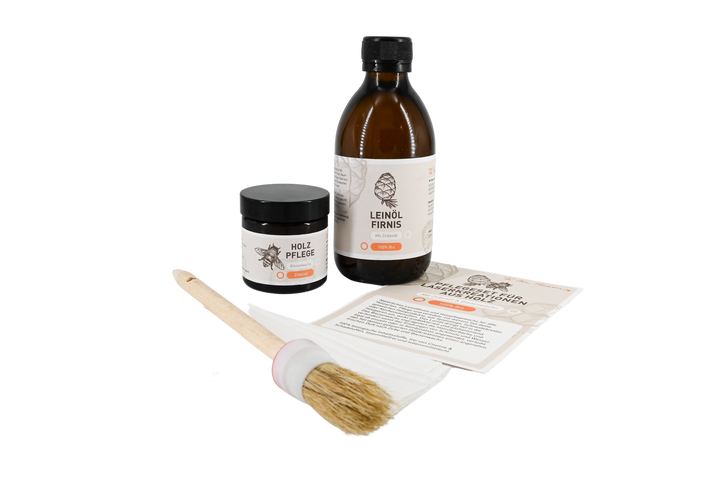Linseed oil is made from pressed linseed and is an essential part of healthy cooking with potatoes and quark. Furniture and articles made of wood can also be treated with this oil. For what reason? Because linseed oil penetrates deep into the wood and forms a water and dirt-repellent structure around the wood fibres. The wood shines with a natural shine, becomes more resistant and is protected against external influences.
Pure linseed oil or linseed oil varnish?
If you use pure linseed oil to care for the wood, there are a few points to consider. You must note when the wood is saturated and wipe off excess oil with a rag. The quality of the oil is crucial, as the drying process for pure oil takes several days. Here it can quickly happen that the oil becomes rancid if the quality is inferior.
Linseed oil varnish, on the other hand, has other properties that allow you to reach your goal faster. At a room temperature of 20 degrees, this oil only needs 24 hours to harden. This ability arises when additives are added to the linseed oil that change the chemical composition and properties.
What is linseed oil varnish?

Varnish made from linseed oil is one of the most well-known means of treating wood. Natural wood protection has been used for centuries when it comes to protecting half-timbered structures, furniture, wooden musical instruments or doors. In the past, pure linseed oil was used to protect the wood; today, varnish is used.
How does this wood protection come about?

If flaxseed is cold-pressed, the flaxseed oil can be obtained. This oil already has a tendency to dry by absorbing oxygen from the air. However, that takes time.
If, on the other hand, drying agents (siccatives) are added to the boiled linseed oil, this is referred to as linseed oil varnish. Due to the addition of heavy metal salts of organic acids, the oil takes on a honey-yellow colour and is slightly viscous. The drying agents act as catalysts during the curing process.
What properties does linseed oil varnish have?
The wood oil protects against external influences such as dirt and dust. Products that you touch every day become more durable through impregnation. The sealed surface structure ensures that scratches rarely get into the wood. Tabletops or instruments, such as a violin, do not wear out as quickly, even with intensive use.
If you use varnish to provide your wooden furniture with a water-repellent protective layer, the colour of the wood will also change. Untreated wooden furniture will become lighter and more faded over the years. With a coat of varnish, the wood shines again in a rich and more intense colour tone, which at the same time ensures a shiny surface of the wood. The grain of the wood also stands out more clearly.
Please note that rags and brushes soaked with linseed oil varnish have a tendency to self-ignite. This is due to the chemical processes that occur during curing. While furniture or kitchen cutting boards won't burst into flames, a brush or rag that has been used to remove excess liquid from the wood easily can. Therefore, wash all tools carefully and do not leave any crumpled up rags with residues of the wood preservative lying around.
Is linseed oil varnish toxic?
The wood oil is non-toxic. You can therefore treat tabletops, wooden boards or wooden toys without hesitation. However, you should stand down the wood before painting or only apply the varnish to untreated wood. With a lacquered piece of furniture, the lacquer must be removed first, otherwise the varnish cannot penetrate the fibres of the wood.
Perfect for maintaining engraved wood

Coating with linseed oil varnish also gives engraved wood more radiance and durability. That's why you can buy a very special wood care set in our shop, which consists of linseed oil varnish, beeswax, a cotton cloth and a brush. Give your wooden furniture a lively look and protection down to the depth of the wood with this coat of paint. The product can also be used on lasered wood. Here it visually emphasizes the lettering or the engraved image in the wood.
The varnish and the beeswax exude the fresh scent of a stone pine, while both products prevent water and dirt from penetrating the wooden surfaces. You can use varnish and beeswax individually or in combination, both penetrate deep into the wood and prevent the growth of fungi and bacteria.
Areas of application
Wood, metals and other materials benefit from a coat of Linseed Oil Varnish as this liquid acts as a corrosion inhibitor and wood preservative. This product can be used to treat and protect furniture, wooden worktops in the kitchen, doors, beams or wooden objects outdoors. The wood oil is also used in boat building or in the treatment of natural stone and cork.
The product is also used in the manufacture of oil paints. Here, oil is added to the colour pigments, the mixture is rubbed and then slightly diluted with turpentine oil to obtain a paintable colour. When restoring vintage cars, the product is used to repair damage to the paintwork. If the original paint peels off, it is stabilized by the protective layer that forms after curing.
How long does linseed oil varnish dry?
Drying does not occur as an evaporative process in which water evaporates. Varnish hardens through oxidation. This means oxygen is picked up from the air and a chemical reaction called polymerisation occurs. If you work with pure linseed oil, the drying time can take several days. This depends on the type of wood treated and the layer thickness that results from repeated application. If, on the other hand, you use linseed oil varnish, it will harden after just 24 hours. In this case, the addition of siccatives ensures a catalysing effect.






